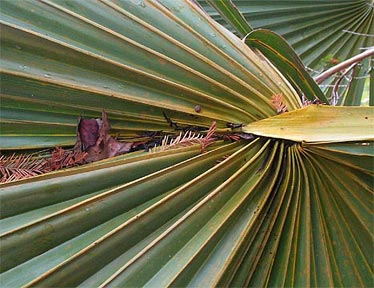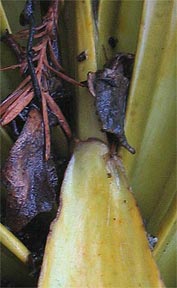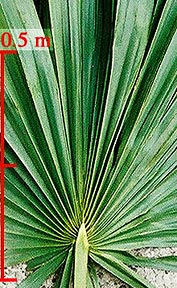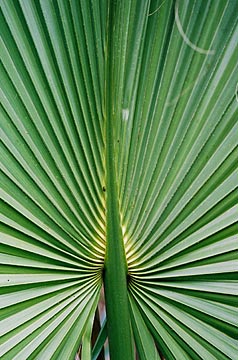
S. mexicana — strongly costapalmate |
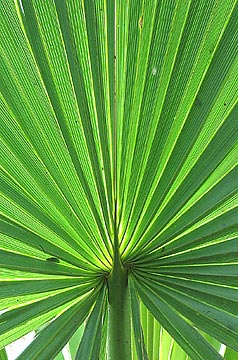
S. minor — weakly costapalmate |
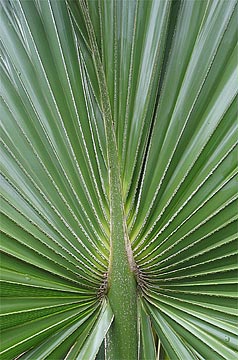
Sabal × brazoriensis — strongly costapalmate |
Abaxial (bottom side) view of the midribs of Texas Sabal species
The costa (midrib) is an extension of the leaf stalk (petiole), clearly visible here. Viewed from the top (adaxial) side S. minor, with its short midrib, typically appears to be palmate, since all leaf segments radiate from the immediate area of the hastula (see below).
Palmate & Costapalmate; Hastula
by Bob Harms ( )
)
In palm leaf morphology the terms palmate, costapalmate & hastula play an important contrastive role; e.g., the first key feature dividing the Palm Family (Arecaceae) in the Flora of North America, Vol. 22, is:
Leaf blades palmate to costapalmate;" and a later feature within that group: "Stems procumbent or ascending; hastula present on both surfaces of leaf.
Within Sabal, the key further contrasts weakly & strongly costapalmate:
2 (1) Leaf strongly costapalmate and curved, ... → Sabal etonia
+ Leaf weakly costapalmate and little if at all curved, ... → Sabal minor
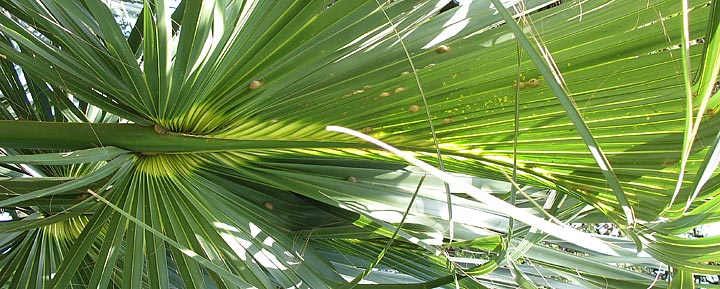
Praha Sabal midrib
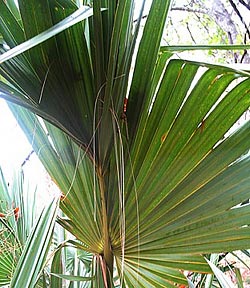
Brazoria Sabal midrib from below |
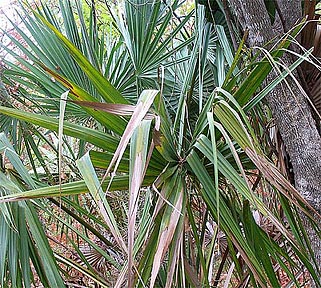
Looking down the midrib of Brazoria Sabal |
Strongly costapalmate Praha & Brazoria Sabal (Sabal × brazoriensis) leaves.
Segments are inserted along the full length of the costa. Being strongly costapalmate tends to entail strong leaf curvature with a centrally depressed blade — making it V-shaped when viewed from tip to base.
A search for definitions of costapalmate, both on the web and in botanical literature, turned up a wide range of usages, a number of which didn't seem entirely correct; e.g., in Manual of the Vascular Plants of Texas (Correll & Johnston 1970):
- Costapalmate
- Palmately ribbed or veined.
- Palmate
- Hand-shaped with the fingers spread; in a leaf, having the lobes or divisions radiating from a common point.
They don't define 'hastula,' but their Sabal key (p. 340) requires it:
- Hastula short and obtuse ... blade palmate .... → S. minor.
- Hastula elongated and acute ... leaf blade costapalmate .... → S. texana.
Their glossary does not distinguish costapalmate and palmate, but the key clearly contrasts them. The glossary does have 'hastate,' a word with only an indirect historical connection with 'hastula' (Latin for 'little spear' - no longer an appropriate metaphor). The acute hastula with S. minor shown below together with the leaf stalk does resemble a spear.
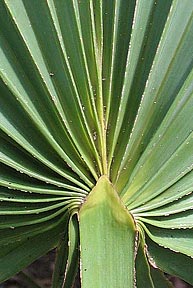
Palmetto Park |
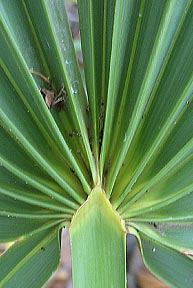
Purola Preserve |
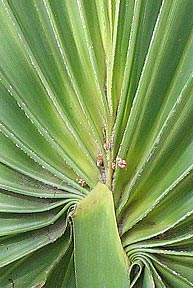
Detail of plant on the right |
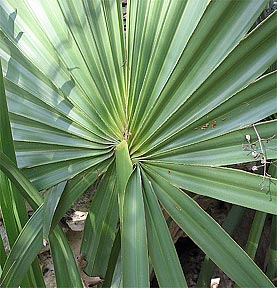
Barton Creek Greenbelt |
The hastula of S. minor plants in 3 different locales.
Note that the two on the left are clearly acute; that on the right, obtuse and asymmetrical. With each, most but not all leaf segments appear to radiate from beneath the hastula, and the others are inserted just above it. The flat surface of the Barton Creek blade contrasts with the strongly costapalmate blades of other Sabal species.
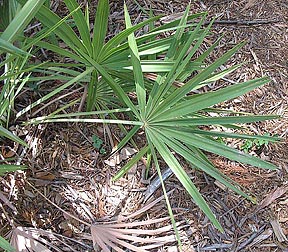
Palmate leaves, no costa |
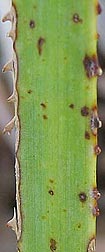
Petiole with spines |
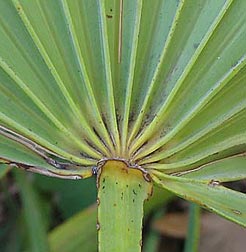
Adaxial (upper surface) hastula. |
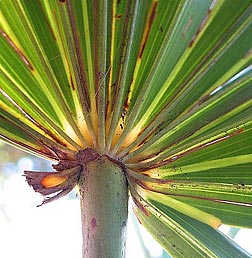
Abaxial weakly developed hastula. |
A palmate species, Serenoa repens (not native to Texas), with hastula on both sides of the petiole/blade, and small spines on the leaf stalk.
The leaf segments all radiate from the edge of the hastula, but not from a single 'point.'
The short informal glossary in M. J. Papay's "An introduction to Cold Hardy Palms" (2004, online pdf file), presents some strange definitions that seem to have little to do with palm morphology and do not seem to help with the plants we have examined.
- Costapalmate
- A leaf where the hastula is elongate and pointy to very elongate and pointy; Hastula resembles an arm that ends in a praying hand whose middle finger may be very long.
- Palmate
- A leaf where the hastula is round or ovoid, not elongate and not
extending along the leaf midrib; Hastula resembles an arm that ends in a fist.
- Hastula
- Found in palmate and costapalmate leaves. The upper leaf-end of the stem where the leaf and pinnae are attached (do not confuse with rachis!).
Brazoria Sabal hastula.Without looking at the full leaf – especially the underside – one might (wrongly in this case) conclude that all segments are radiating from the area of the hastula. [Contrast the full
leaf lying flat, with no clear evidence of a long costa.] The leaf blade on the left is clearly curved, upward from each side then down into a central depression or groove, which had begun to collect debris in this photo.
The separation of the rounded hastula tip from the midrib and adjacent leaf segments is visible in the detail view.
Interestingly, the Missouri Botanical Garden online glossary defines only palmate:
- palmate
- a once-compound leaf divided into several leaflets which arise at the same point, there being no rachis, cf. pinnate.
[Emphasis added by BH; note that 'no rachis' (= axis) might seem to exclude costapalmate.]
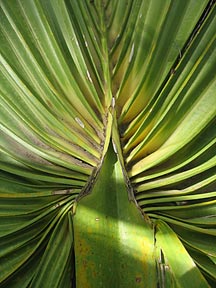
Leaf base with hastula |
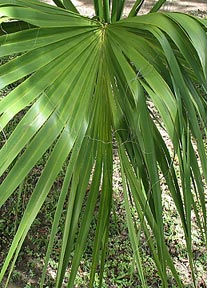
V-shaped Midrib |
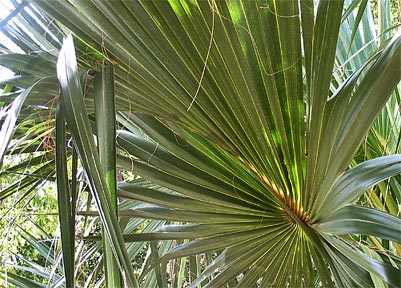
Curved midrib on leaf underside |
Sabal mexicana The hastula edge is raised; the segments arising well above it, especially salient from the bottom side. Viewed from tip to hastula (visible here) the central depression may be noted.
Clearly the best definitions are those in the comprehensive 2008 palm handbook, Genera Palmarum, The Evolution and Classification of Palms (Dransfield et al) [Emphasis added by BH]:
- Costapalmate
- shaped like the palm of a hand and having a short midrib or costa [BH note: The key component of this term is the extension of the petiole (leaf stalk) as a midrib/costa.]
- Palmate
- shaped like the palm of the hand, all ribs or leaflets arising from a central area [BH note: the segments of a palmate leaf usually project to an area rather than to a point.]
- Hastula
- a flap of tissue borne at the insertion of the blade on the petiole on the upper, lower, or both leaf surfaces
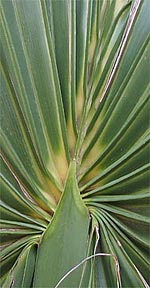
Leaf base with hastula |
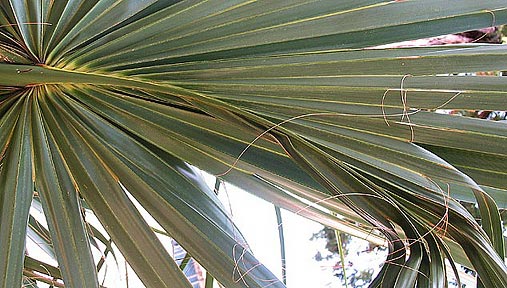
Midrib |
Sabal etonia [
Contrast with the S. minor images above.] The hastula is more acute, and the segments arising well above the hastula are easy to discern. The curved midrib seen from below gives an even clearer picture of segments radiating along its length to its very tip.














